Introduction
A gun is one of the most common and recognizable symbols in the world, and it’s also one of the most challenging to draw. Even for professional artists, drawing guns can be incredibly difficult, because each weapon has its own unique design that might not be immediately obvious from its overall shape alone.
If you want to learn how to draw a gun –this step-by-step guide will walk you through the process in no time. Once you follow the steps in this guide, you’ll be able to draw realistic guns with ease. Here are the basic steps on how to draw a gun
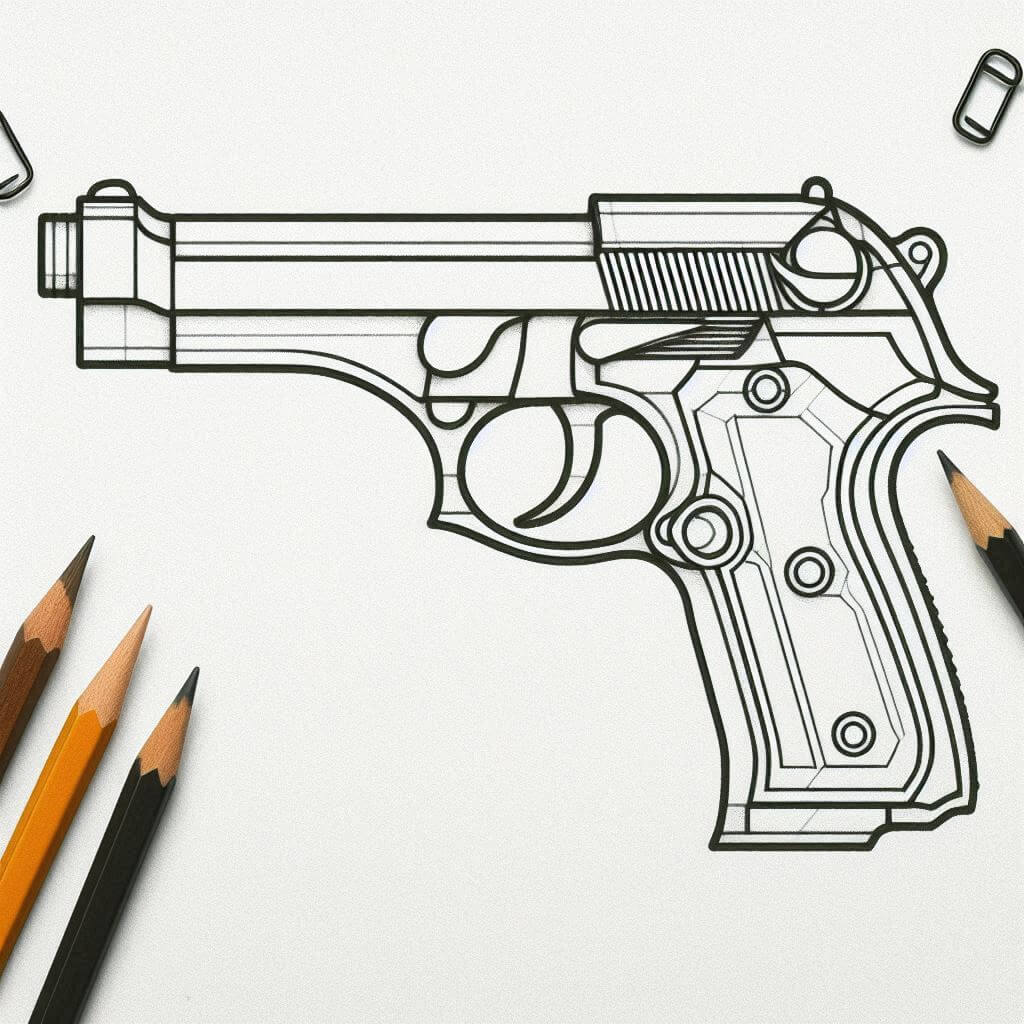
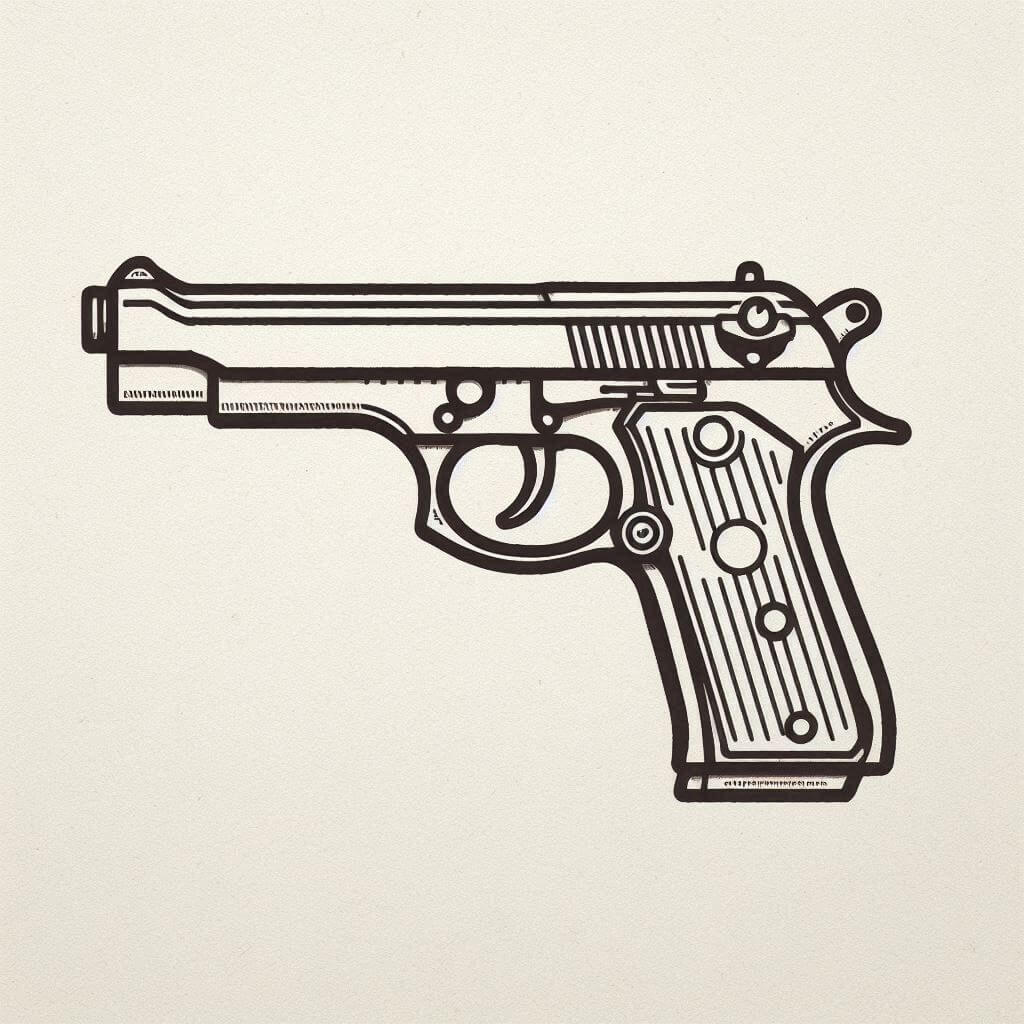
Method – 1
Start with the basic shapes
Drawing a handgun doesn’t have to be hard. Start with the base shapes and then work your way up. The first thing you need is two circles, one for the grip and one for the barrel.
The next shape you need is the trigger guard which should look like an oval on top of the grip circle. You can also draw this shape as an oval all around the outside of the grip, but I think it looks better when it’s just on top of it.
If you’re drawing a revolver, make sure the barrel starts at the back of the grip and curves upwards towards where the cylinder will go.
Add detail
- Begin drawing the barrel of the gun. It should protrude from the body of the weapon, and should be long enough to be seen on either side of it.
- Draw two slanted lines coming out the top of it, as if they are pointing in opposite directions. These lines represent the direction that bullets will come out. It is worth noting that these details make up only one type of handgun, so feel free to experiment with shapes and features for your own style.
- Start adding detail inside the trigger area. The trigger itself should have a rectangular shape with a circle at the end, which represents where your finger goes when you pull it back to fire. At this stage you can also start detailing any other important parts of the gun like sights or a handle at the bottom.
Add shadows
Add shadows and highlights using a light, medium, and dark shade of grey. This will make your drawing more realistic.
Detailing the handle
- Drawing the handle is the most time-consuming part of the project, but it can be done easily.
- Draw an egg-shaped shape on the right side of your drawing with pencil.
- Draw an oval on top of it (to represent where your hand will go).
- Draw two shapes on either side of the oval that taper to make space for your thumb.
- Erase any stray lines and you’re finished!
The trigger and hammer
In order to illustrate the trigger and hammer, we’ll need two lines that are perpendicular to each other. One should start from the back of the handle and extend out towards the barrel, while the other should come from the front of the handle and extend out towards the barrel at an angle.
The first line will be about four inches long, while the second will be about 1.5 inches long.
Drawing the muzzle end : The muzzle end is illustrated as a circle that’s roughly one inch in diameter on top of the very end of the barrel.
Adding details for realism
Once this is done, you can add some more detail to your sketch for added realism! You can use parallel lines to create the grooves around the grip of the gun. You can also add rivets or screws around the edge of the grip. You could also use small circles to create circular shapes on various parts of your design.
Another way to make your design look real is by using shading techniques that involve simply drawing darker versions of what you already have next to it!
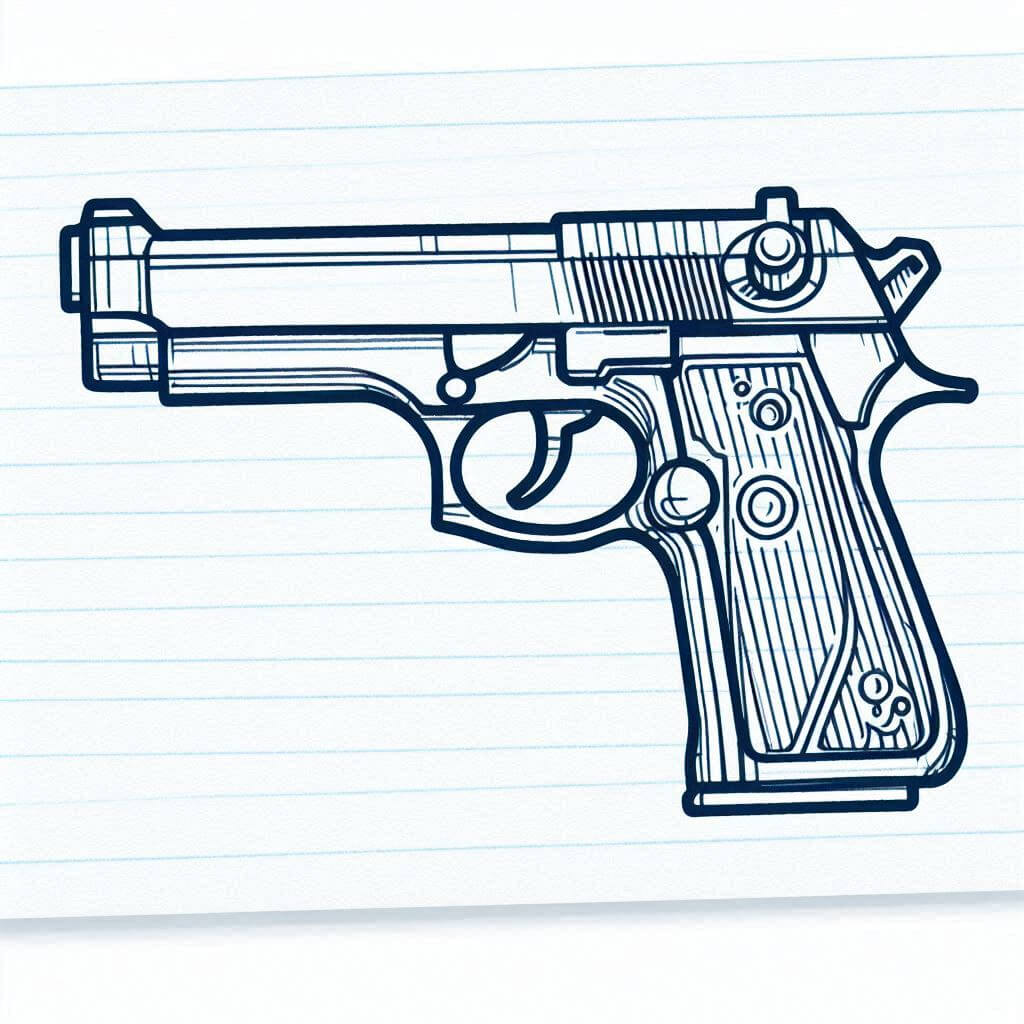
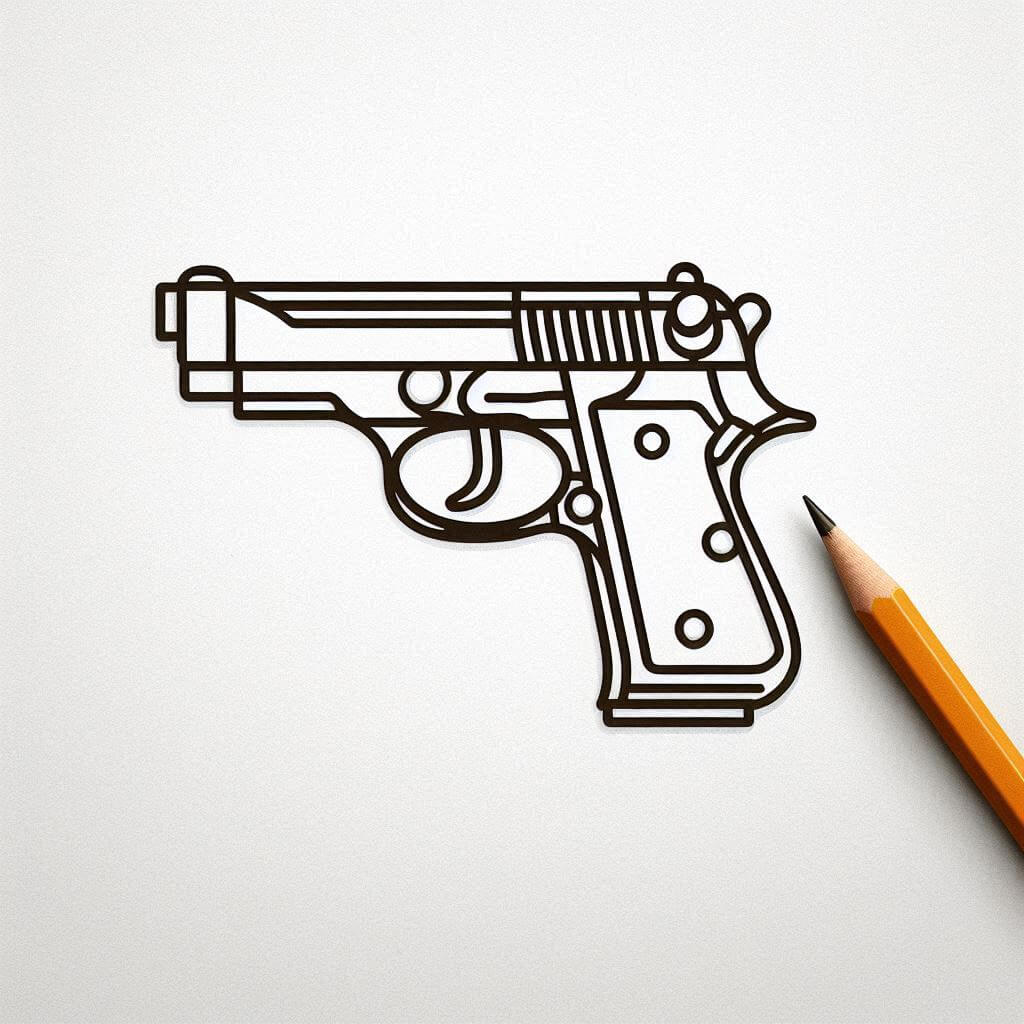
Also Read: Crown Drawing: A Step-by-Step Guide
Method – 2
Laying the Foundation: Basic Shapes
Before diving into intricate details, let’s establish the gun’s core structure using basic shapes. Imagine the gun as a collection of interconnected forms. Here’s where your artistic eye comes in!
- Grip and Barrel: Start with two circles. One, larger than the other, represents the grip, where you hold the gun. The smaller circle depicts the barrel, the part that propels the bullet.
- Trigger Guard: Now, add an oval shape on top of the grip circle. This forms the trigger guard, protecting your finger from the trigger mechanism.
- Revolvers: If you’re drawing a revolver, the iconic firearm with a rotating cylinder, visualize the barrel starting at the back of the grip and curving upwards. This leaves space for the cylinder, which will be added later.
Remember: These are just starting points. Experiment with shapes and sizes to achieve the specific gun you have in mind.
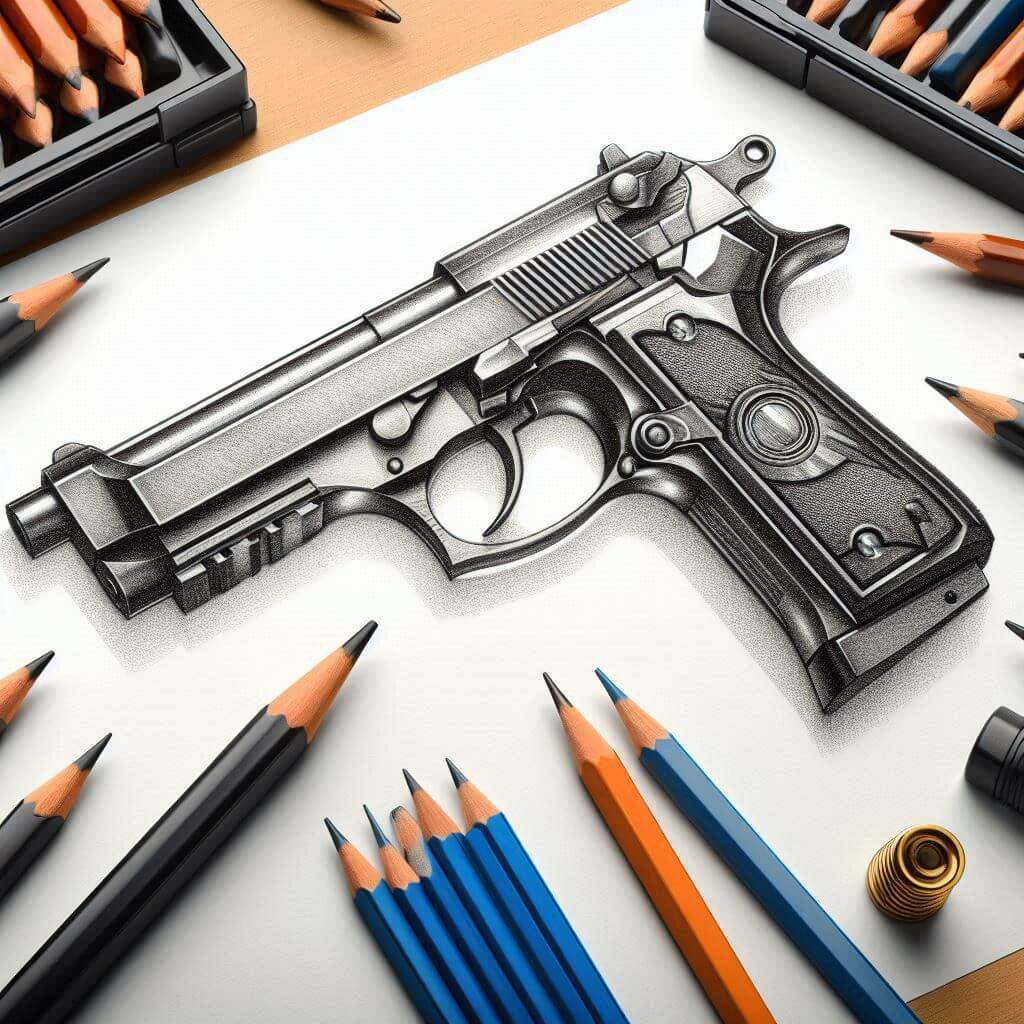
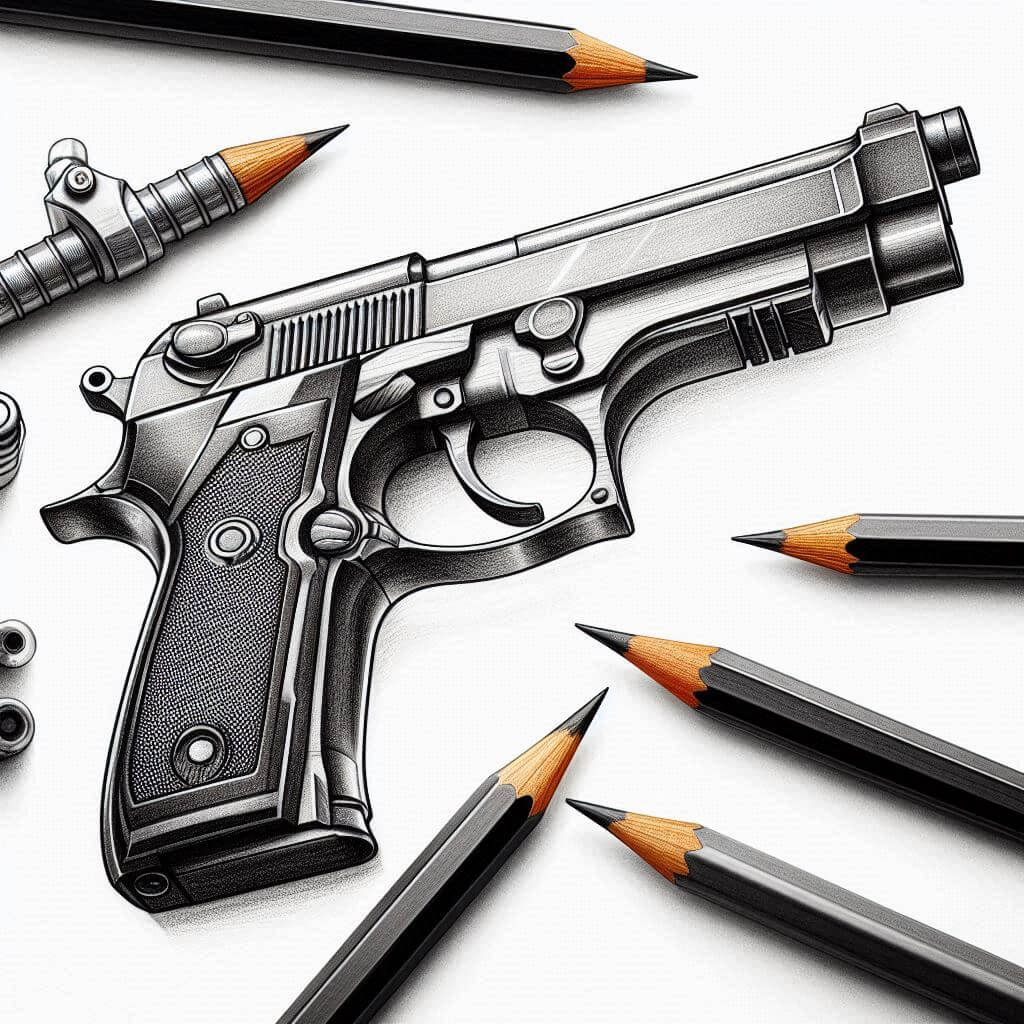
Building Upon the Basics: Adding Details
Now that we have the gun’s basic structure, let’s refine it with details that bring it to life.
- The Business End: Barrel and Sights
- Extend the barrel from the grip, ensuring it’s visible on both sides.
- Draw two slanted lines emerging from the top of the barrel, pointing in opposite directions. These represent the sights, crucial for aiming. Remember, different gun types have varying sight designs. Research specific models for accurate detailing.
- Trigger Area: Zoom in on the trigger guard. Inside, sketch a rectangular shape with a curved end – the trigger. This is where your finger goes to fire the gun.
- Additional Features: Don’t forget other crucial elements like the safety switch and the magazine release (if applicable). Research the chosen gun model to identify these features and incorporate them into your drawing.
Bringing Depth: Shading and Highlights
A flat drawing lacks realism. To breathe life into your creation, introduce shadows and highlights. Here’s how:
- Shades of Gray: Use a light, medium, and dark shade of pencil (or your chosen medium) to create shadows and highlights. Shadows typically fall on the opposite side of the light source. Experiment with different lighting angles to achieve dramatic effects.
- Highlighting the Details: Use a light touch to add highlights on raised areas like the top of the barrel and the edges of the grip. This creates a sense of depth and emphasizes the gun’s form.
Pro Tip: Reference photos of real guns to understand how light interacts with their various surfaces.
Refining the Grip: The Finishing Touches
The grip is a crucial area for detail and visual appeal. Here’s how to refine it:
- Shape It Up: On the right side of your drawing, sketch an egg-shaped form – the base of the grip.
- Hand Placement: Draw an oval shape on top of the egg shape, representing the area where your hand would rest.
- Thumb Space: On either side of the oval, create two tapering shapes to accommodate the thumb’s natural position while holding the gun.
- Cleaning Up: Once satisfied with the grip’s form, erase any unnecessary lines to create a clean and finished look.
Remember: Grip designs vary depending on the gun type. Research specific models to capture the unique grip characteristics.
The Finishing Touches: Trigger, Hammer, and Muzzle
Let’s add some final details for a truly complete drawing:
- Trigger and Hammer: Draw two perpendicular lines to illustrate the trigger and hammer. One line extends from the back of the handle towards the barrel, representing the hammer. The other, shorter line, starts at the front of the handle and angles towards the barrel, depicting the trigger.
- Muzzle End: Imagine a small circle roughly one inch in diameter. Place this circle on the very end of the barrel to represent the muzzle, the opening from which the bullet exits.
Advanced Techniques: Taking Your Gun Drawing to the Next Level
Now that you’ve mastered the fundamentals, let’s explore some advanced techniques to truly make your gun drawings stand out:
- Material Variations: Guns come in various finishes, from the matte black of a tactical pistol to the gleaming chrome of a revolver. Experiment with different shading techniques to capture these material properties. For a metallic look, use a blending tool to create smooth transitions between light and shadow. For a matte finish, focus on creating sharp contrasts.
- Reflective Surfaces: Some gun parts, like the barrel or sights, can be highly reflective. To depict this, use a very light touch to create thin, white highlights where light would directly reflect.
- Depth of Field: If you’re drawing a scene featuring a gun, consider using depth-of-field techniques. This involves blurring the background elements while keeping the gun in sharp focus. This draws the viewer’s eye to the gun and creates a sense of realism.
Beyond the Basics:
- Action and Movement: Guns are often associated with action and movement. Consider incorporating these elements into your drawings. You could draw a gun being fired, with smoke billowing from the barrel, or a character holding the gun in a dynamic pose.
- Background and Context: Don’t let the gun exist in a vacuum. Create a setting or context for your drawing. Is it a detective holding the gun in a dimly lit room? Or a soldier wielding it on a battlefield? A well-crafted background adds narrative depth to your artwork.
- Research and Reference: Throughout the drawing process, refer to real-life gun photos or blueprints. This helps ensure accuracy in proportions, details, and overall design. There are countless online resources and gun enthusiast forums that offer high-quality reference materials.
Also Read: Coffee Cup: How to Draw a Coffee Cup Step by Step










